For any pet owner, a vomiting cat or a cat with diarrhea is cause for concern. Since cats are vulnerable to a wide variety of different causes of an upset stomach, chances are, one or both has happened to your pet, but it’s often hard to know what to do. Do you rush them into the vet? Do you just let it pass?
Naturally, it depends. This article discusses the causes and symptoms of diarrhea and vomiting and cats, and discuss your options for home care, as well as when it’s time to take your sick cat into the veterinarian.
What is vomiting and diarrhea in cats?
Cat diarrhea (abnormally loose or liquid stools) and cat vomiting (the act of expelling content from the stomach through the mouth) is an unfortunate, but common part of pet ownership. In fact, they are the most common symptoms of upset stomach seen in cats.
Each fall under the term gastroenteritis, meaning an upset or inflamed stomach and intestines. Same as with people, diarrhea and vomiting can be caused by various underlying problems, ranging from minor to serious or even life-threatening.
Generally, vomiting points to irritation in the stomach and upper small intestine, and diarrhea indicates irritation anywhere along the intestinal tract. Vomiting and diarrhea can occur alone, or together and can be associated with an increased frequency of bowel movements.
But whenever either occurs, the underlying cause must be found and eliminated before it becomes a bigger problem. Chronic vomiting or diarrhea, meaning occurring regularly more than two to three times a week, can be a sign of a serious health issue.
What causes cat vomiting and cat diarrhea?
There are many possible causes for your cat’s vomiting and diarrhea. Theses can include overeating, eating something that they can’t digest, a change in your cat’s diet, infection and larger health issues. Most times, you will be able to trace the cause of your cat’s diarrhea or vomiting, but others can be more perplexing. Here are six of the possible causes.
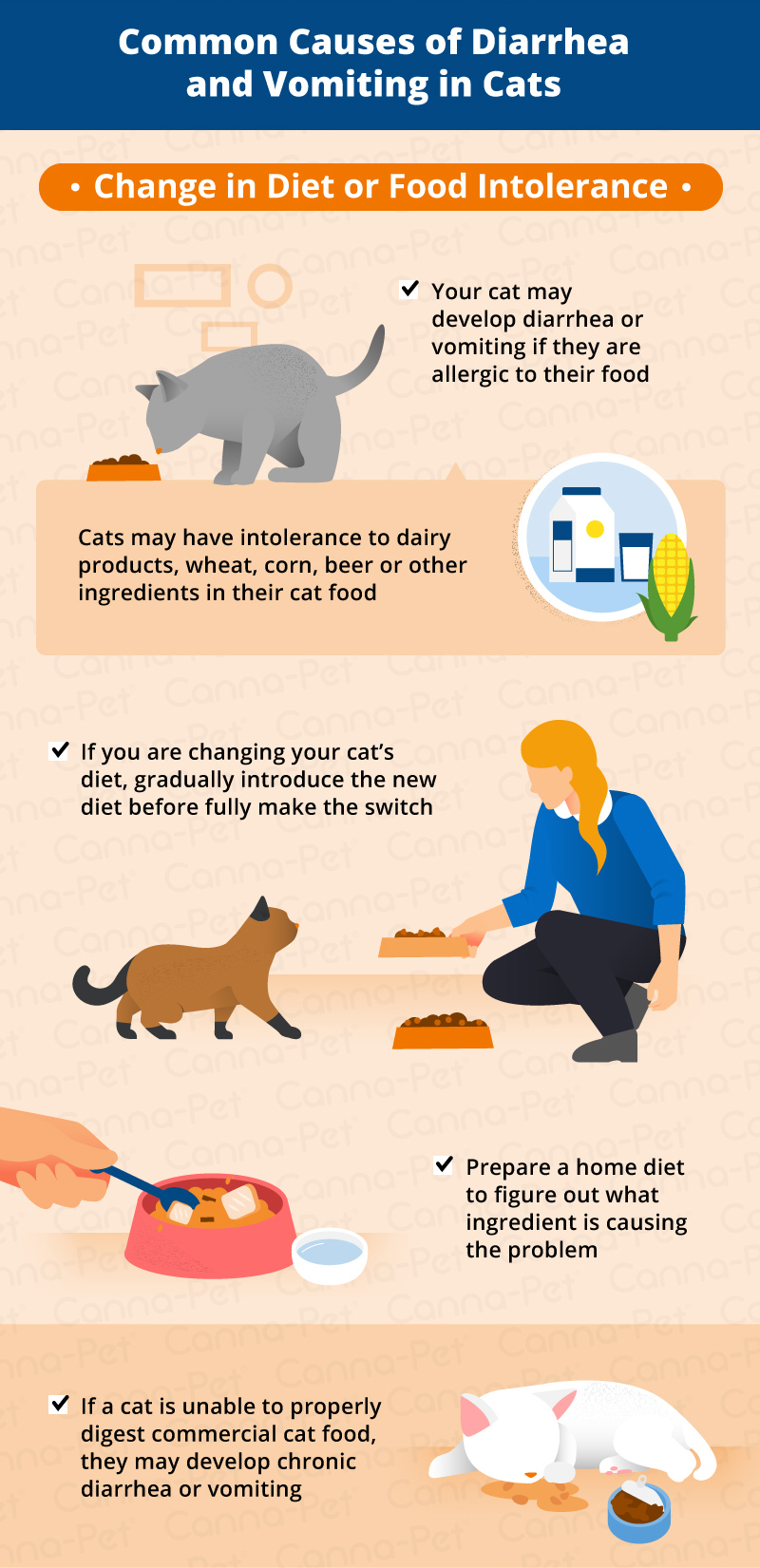
Change in diet or food intolerance
If you recently changed your cat’s diet, he or she may experience some vomiting and diarrhea. Your cat may not be able to tolerate one (or more) of the ingredients in their new food, known as food intolerance. Cats may have intolerance to dairy products, wheat, corn, beer or other ingredients in their cat food.
To avoid this, you can try to gradually introduce the new food into their diet before you fully make the transition. This can help avoid negative reactions. You can also change back to their original food, or prepare a home diet to figure out what ingredient was causing the problem. Then you can re-start the process without the problem-causing ingredient. Your vet can help your form a transition diet, and sometimes a prescription diet may be required.
Some cats also may not be able to process commercially prepared foods as well as you’d like. These cats can often develop chronic diarrhea and vomiting, leaving them unable to properly absorb the nutrients they need from their food. This will cause low energy levels and deteriorate the quality of their coat.
Chronic diarrhea also correlates with inflammatory bowel disease, wherein the cat’s intestine becomes chronically inflamed and irritated. This will be extremely uncomfortable for your cat, and if left untreated, can also develop into lymphoma, a type of cancer in cats.
Eating something toxic
As naturally curious animals, cats are known to get into other things like the garbage and plants, or anything else they might find appealing. Sometimes, these items will contain toxic elements that cause the cat to throw up or have diarrhea. This is an acute form of poisoning, but can also be quite serious, depending what they consumed and how much.
There are several foods, plants and other items that are toxic to cats, but a few of the more common items include:
- Alcohol
- Chocolate
- Raisins
- Chewing gum containing xylitol
- Rat poison
- Aloe Vera plant
- Raw plants from the potato family
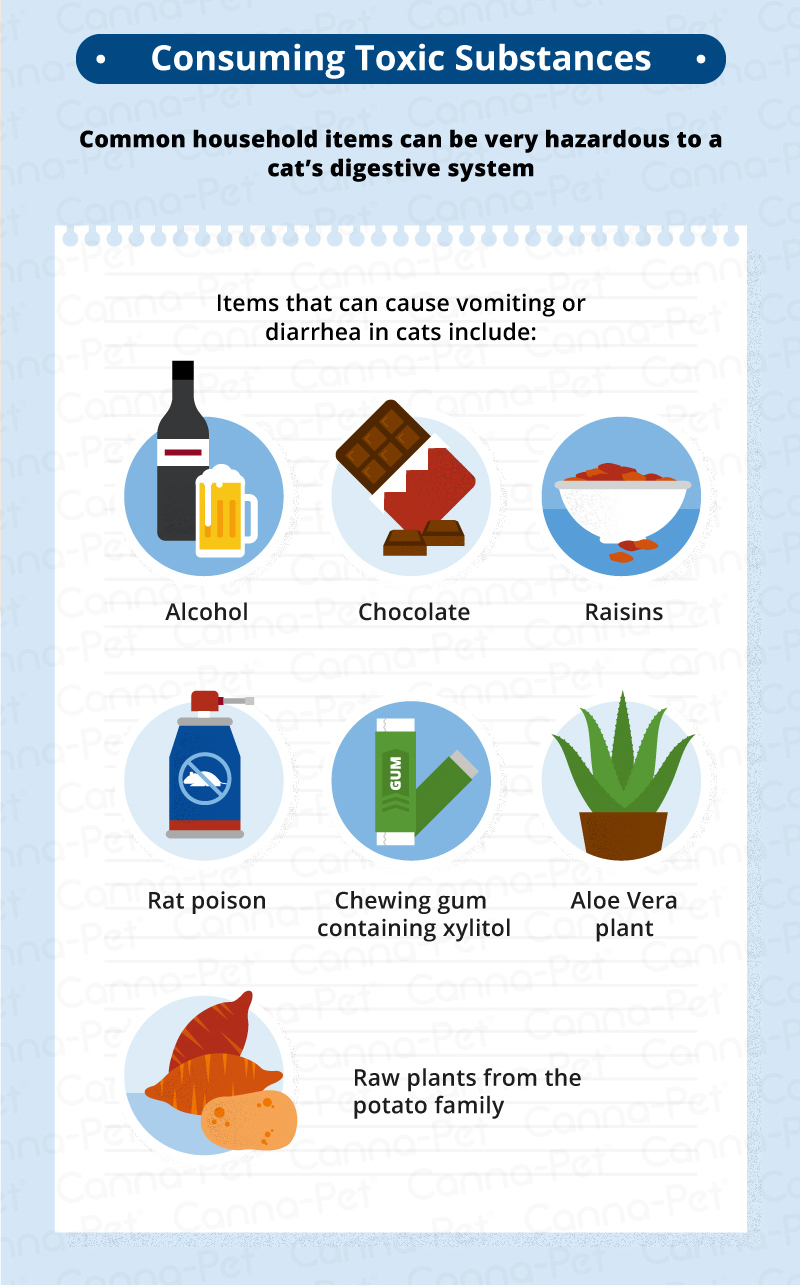
Gastritis or Enteritis
Gastritis and enteritis are conditions that can cause vomiting and diarrhea. Gastritis occurs when the stomach lining is inflamed, while enteritis refers to the irritation of the lining of a cat’s small intestine. When both of these conditions occur at the same time, it is called gastroenteritis. This condition can be caused by food, viruses, parasites, bacteria or fungi.

Intestinal Parasites
Parasites and worms in the intestines can cause stomach irritation, making a cat likely to vomit and have diarrhea. When this is the cause, there will be worms or pieces of worms visible in your cat’s feces.
Tapeworms, hookworms, roundworms, coccidia or giardia are known to often infect cats. Your vet can help you eradicate the worms through medication and fluid therapy may assist if your cat is severely dehydrated.
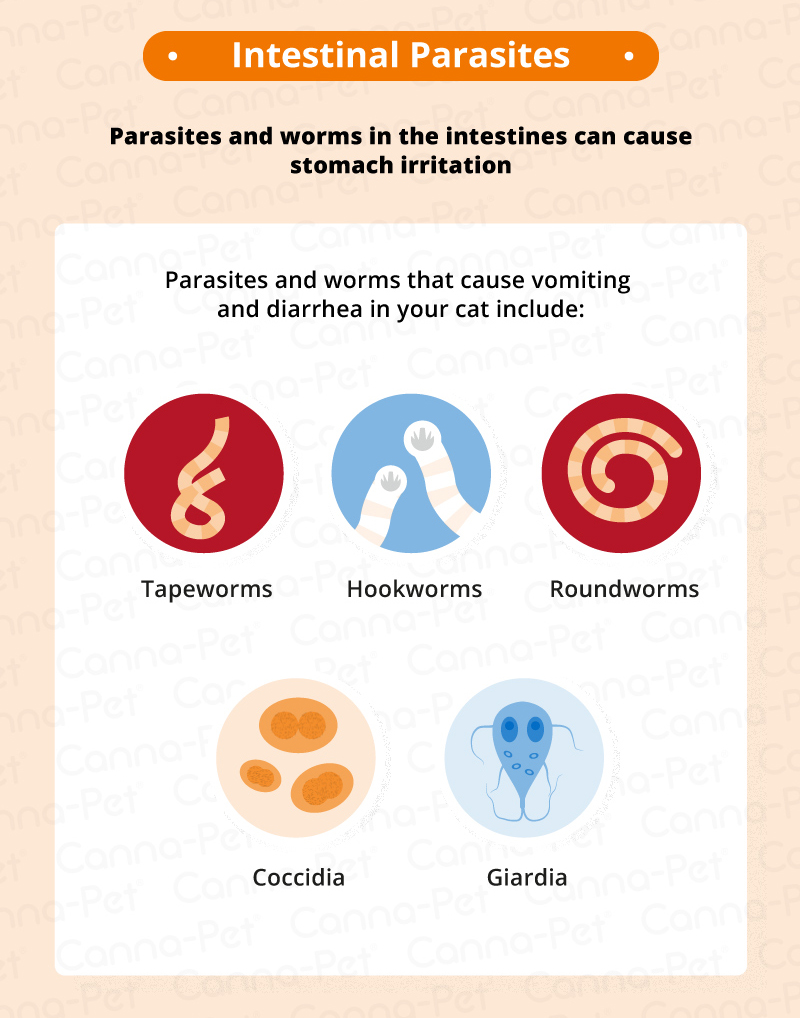
Various bacteria, fungi and infections
There are many forms of bacteria, viruses and fungi that can be the primary cause of your cat’s vomiting and diarrhea. The most well-known bacteria that causes cat vomiting and diarrhea is Salmonella, which is found in infected meats and food. Cats also frequently get yeast infections, caused by fungi. When the yeast infection affects the intestines, your cat will have watery stools and may vomit as well.

Heat stroke
Since they are covered in fur, cats lack an efficient way to cool themselves down. Cats eliminate heat through their paws. If the temperature is too high, your cat can often have a heat stroke.
Cats will often vomit or have diarrhea if they are having a heat stroke, but in worse cases, they will have seizures or go into a coma. If the symptoms are minor, try to cool your cat down with cold compresses.

Identifying the cause of your cat’s vomiting or diarrhea:
Because your cat can’t communicate with words, your veterinarian depends on you for important information. If you bring your cat into the vet, prepare to answer questions that will help the vet identify the cause.
Here are some things you can take note of to help your vet out:
- Are there any foreign materials in your cat’s vomit or diarrhea? Things like bones, sticks, leaves, grass, toys or garbage are often seen in vomit or feces. (If you notice any of these in your cat’s vomit or diarrhea, it is most likely the cause and you may not need to see your vet.)
- Is your cat’s vomit or feces dark? Dark, gritty vomit that looks like coffee grounds can mean irritation or bleeding in the stomach. Dark feces that looks like tar may indicate bleeding in the stomach or high up in the intestines. The blood looks so dark because it is digested before it is passed.
- Is your cat’s diarrhea watery or covered with mucus? This usually means an issue with your cat’s colon, which is responsible for absorbing excess moisture from the stool.
- Are there any streaks of red, undigested blood in your cat’s feces? This typically indicates an issue lower down in the digestive tract, usually the colon or rectum.
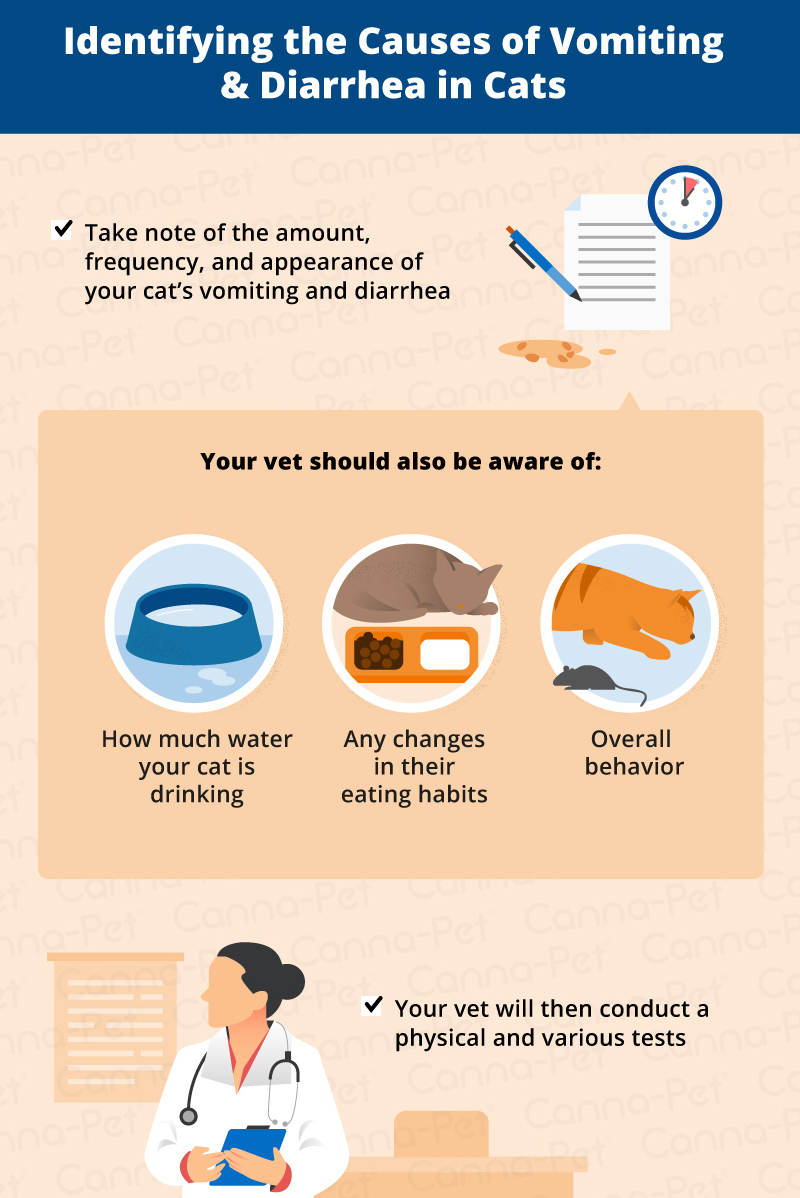
You should also take note of the amount, frequency, and appearance of your cat’s vomiting and diarrhea. You can also take a sample to show your veterinarian—it’s not weird; it’s actually quite helpful. Also pay attention to how much water your cat is drinking, if they are eating normally, or if they are otherwise acting as they typically would.
After this round of questioning, your vet will perform a physical, and may need to run some tests, including:
- Blood work to look for organ problems like kidney disease
- Fecal testing to check for intestinal parasites or other abnormalities
- Abdominal X-Rays or ultrasound to look for masses, foreign bodies or signs of obstruction
More specific diagnostic tests may be recommended depending on the results of these tests.
Treating Cat Vomiting and Diarrhea
In minor cases or vomiting or diarrhea, your cat will often get better with simple home care. Some minor fasting and fluids may be all it takes, and sometimes they just need to get whatever it was that caused the issue out, and they return to normal.
Sometimes your cat’s stomach lining is irritated, but they are still hungry, so they will eat and continue to vomit. In these instances, withhold your cat’s food, and after a couple of hours, if he has not vomited, give him a little water. If they don’t vomit after drinking small increments of water, you can gradually reintroduce a bland diet.
Make sure not to overfeed your cat, as their stomach is still sensitive and they may vomit or have diarrhea again. You can feed them short doses of the bland food every few hours as they tolerate it. You may continue this process for a couple days as your cat improves before gradually returning them to their regular diet. Antacids may also help your cat’s upset stomach.
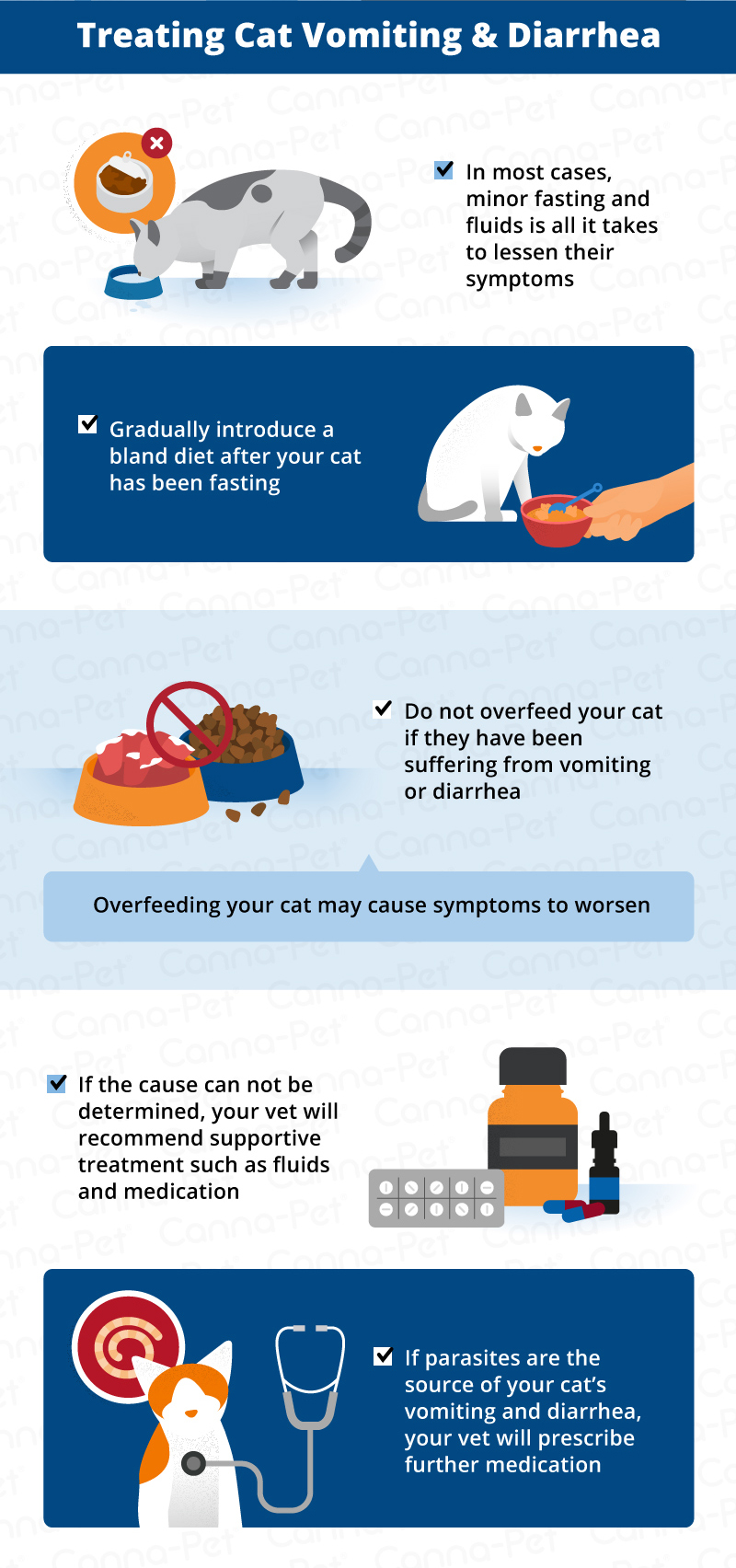
However, sometimes treatment is not this simple. If the cause can’t be determined, your vet will often recommend supportive treatment, such as fluids and medications.
When parasites are the cause of your cat’s vomiting or diarrhea, your vet will usually prescribe medication. If your cat encounters severe, long-lasting gastroenteritis, your vet may give your cat fluids intravenously or under the skin to protect against dehydration. Additional medications may also help calm the gastrointestinal tract and decrease your cat’s urge to vomit.
In more severe cases, when the vomiting and diarrhea are caused be serious problems like liver or kidney failure, cancer, or other severe viral infections, emergency surgery may be required. In these cases, hospitalization for continued treatment and observation is recommended.
Whatever the cause or severity, do not administer any medication to your cat without first checking with your veterinarian. Many medications are dangerous to cats, so it is important to consult your veterinarian first to avoid toxicity.
When should you go to your veterinarian?
It’s hard to know what constitutes as an emergency, but there are some general guidelines to follow for cat vomiting and diarrhea. If your cat’s vomiting or diarrhea continues over a prolonged period of time, or gets worse, it’s time to go see your veterinarian. Likewise, if there is blood in either the vomit or feces, see your vet immediately. Several other signs may indicate a medical emergency.
See your veterinarian if:
- There is blood in your cat’s vomit or diarrhea
- Your cat vomits and has diarrhea simultaneously
- The vomit that looks and smells like stool
- Your cat projectile vomits
- Your cat has sporadic vomit or diarrhea with no relationship to meals
- There are multiple bouts of vomiting or diarrhea over a short period of time
- Ingestion of poison is suspected
- Your cat bloats and tries to vomit, but cannot
- Your cat appears listless, loses weight or shows other signs of illness, such as labored breathing or pain
- Fever and other signs of toxicity
At some point in time, you most likely will encounter a vomiting cat or cat with diarrhea. Knowing how to help treat your cat can be as simple as giving it time, but when things seem more severe, always bring them in to see your veterinarian and get them the professional care they need. As they saying goes: better safe than sorry!
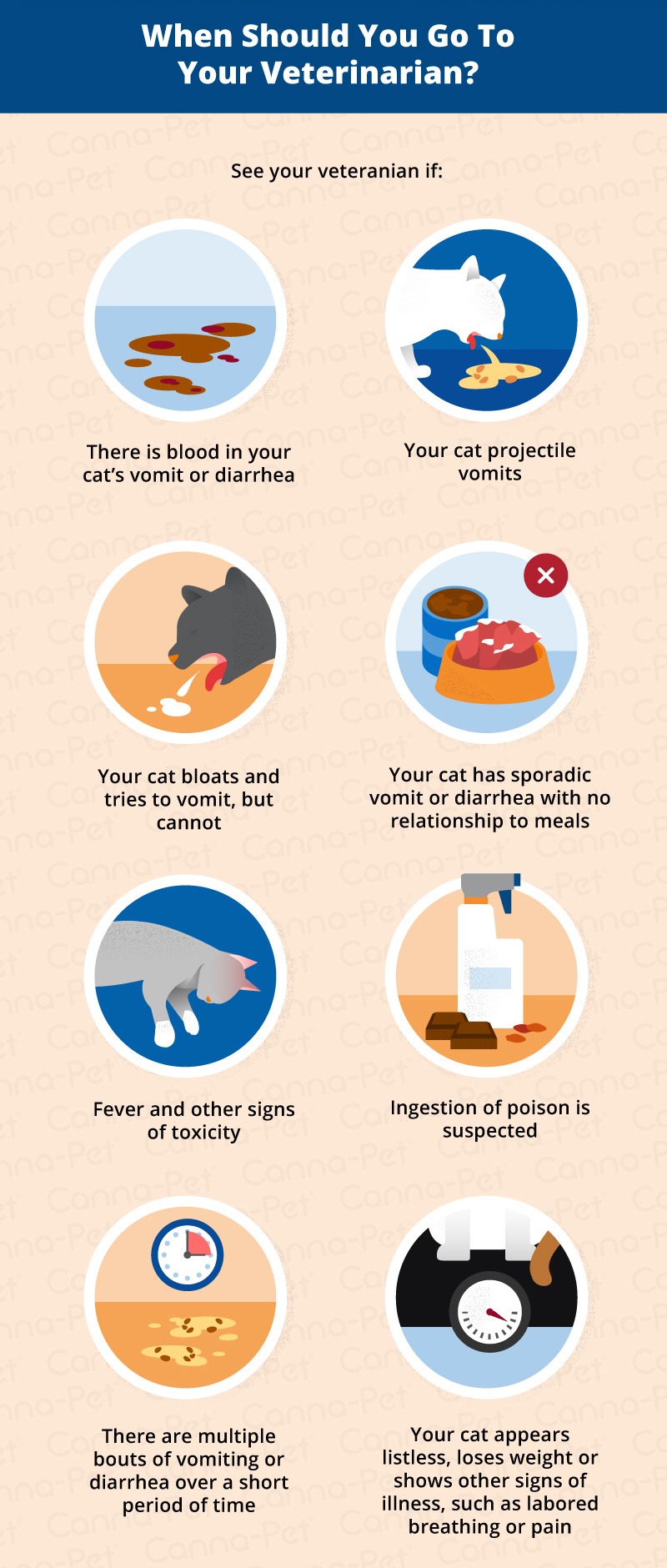
Sources:
- “Diarrhea Causes and Treatments for Cats.” WebMD, Accessed 26 March 2017. www.pets.webmd.com/cats/guide/cat-diarrhea#1.
- “What Causes Cats to Vomit?” WebMD, Accessed 26 March 2017. www.pets.webmd.com/cats/what-causes-cats-vomit.
- “Inflammatory Bowel Disease in Cats.” Pet Health Network, Accessed 26 March 2017. www.pethealthnetwork.com/cat-health/cat-diseases-conditions-a-z/inflammatory-bowel-disease-cats.
- “Vomiting and Diarrhea (Gastroenteritis) in Dogs and Cats.” Vetstreet, 24 March. 2014, Accessed 26 March 2017. www.vetstreet.com/care/gastroenteritis-vomiting-and-diarrhea-in-dogs-and-cats.
- “Causes of Cat Vomiting and Diarrhea.” VetInfo, Accessed 26 March 2017. www.vetinfo.com/causes-cat-vomiting-diarrhea.html.






